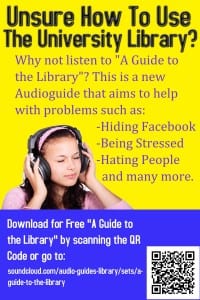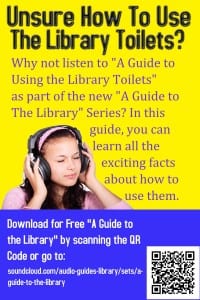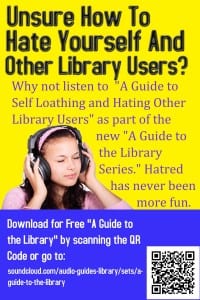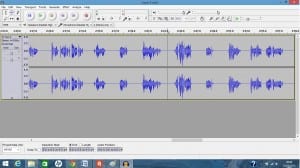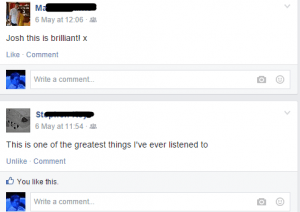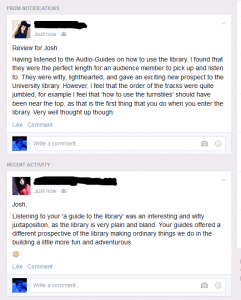Framing Statement
My performance piece A Guide to the Library is an audio guide that instructs listeners to use the library in ways that are less idealistic than what is normally considered to be proper usage of an educational library. In the guide, I speak in an artificial manner whilst instructing and regularly repeat phrases throughout the chapters, such as “Pause this recording, until you are prepared” (Curran, 2015a) and “For this recording, you should be…” (ibid) Yasunao Tone writes, “Audio guides have a performative function.” (Tone, 2011, 102) My audio guide upholds this as it instructs listeners to perform tasks that range from the mundane to the impossible.
Below is a list of the names of each chapter:
- A Guide to Listening to ‘A Guide to the Library’.
- A Guide to using Facebook while Pretending to Work in the Library.
- A Guide to Doing an Essay the Day Before it’s Due.
- A Guide to Using the Library Turnstiles.
- A Guide to Using the Library Toilets.
- A Guide to Being Quiet on the Silent Floor of the Library.
- A Guide to Dealing with Stress in the Library.
- A Guide to using the Library to Escape Loneliness.
- A Guide to Self Loathing and Hating Other Library Users.
- A Guide to Reconsidering All Your Life Choices in the Library.
- A Guide to Who You Are.
This was distributed in the form of MP3 files hosted on Soundcloud that could be downloaded or streamed at any time convenient to the listener. Marketing was done through a Facebook event page and these three posters which were displayed in various parts of the Library.
I wanted to create a performance that could engage with a diverse group of library users, not just Drama students. To do this, I wanted to make something that combined humour with commentary about the lives of the listeners. This was partly inspired by the work of Andrea Fraser, an American performance artist most well known for her work, Museum Highlights. Another influence was my previous experience of audio guides. I have found in the past that instructional audio guides often came across as patronising and overextended. I thought that this would be a suitable style for my performance as I could parody the style of audio guides and satirise the idealistic views on how the library should be used.
I wanted my performance to comment on the people who use the library instead of the building itself, because as Sue Palmer writes, “It’s not just about the place, but the people who normally inhabit and use that place. For it wouldn’t exist without them.” (Palmer, 2002, 145) I wanted it to reflect the student experience of the library, ranging from the playfully defiant, such as hiding Facebook, to the harsher truths, such as self loathing and loneliness.
The final chapter of the guide explains my aims behind this performance whilst still in the character of the speaker of the past chapters. In it, I talk about the reasons behind the performance and I also comment, “I realise now that all I’ve done is just point out problems and give useless solutions.” (Curran, 2015b) I thought it important to point this out, because even though I comment on some of the psychological and emotional stresses of using the library, I am powerless to change anything for the better.
Analysis Of Process
The Prototype
During one of the earlier weeks of the module, the members of our group were each given the individual task of creating an Artist’s Book based on the title of a potential book we had invented in a previous exercise. As I am more confident designing audio work than visual work, creating an audio book was the clearest choice. I initially shortlisted two titles I had invented to adapt into an audiobook: ‘A Guide to Breathing’ and ‘Car Alarms: Ranked by Irritation Level’. I chose the former because I believed that the novelty of irritating car alarms would wear off fast.
Using a very basic microphone, I narrated the guide which included various sound clips of normal breathing and breathing disorders. The recording was well received by the group, which led me to research ways in which I could improve upon this idea. (note: Don’t try and play any of the Soundcloud tracks on a University computer. It doesn’t work.)
Analysis of the Work of Andrea Fraser
One of the main inspirations on my writing style for my audio guide was the work of Andrea Fraser. In 1989, Fraser performed a site-specific piece called Museum Highlights (Fraser, 1989) in which she took the role of a tour guide in the Philadelphia Museum of Art. She did this in the persona of Jane Castleton and led tour groups around who were unaware that they were part of a performance.
She initially starts out behaving like a genuine tour guide, but soon starts to analyse the areas of the site that are not intended for artistic observation: “Jane enters the cafeteria: “This room represents the heyday of colonial art in Philadelphia on the eve of the Revolution, and must be regarded as one of the very finest of all American rooms.”” (Fraser, 1991, 121) She keeps the group engaged with surreal humour, referencing both her tour and her true identity:
“For $750,000 you could name the Museum Shop. You know, I’d like to name a space, why, if I had $750,000 I would name this shop, um … Andrea. Andrea is such a nice name. Jane walks a few feet further down the corridor and stops again to address the group: This is our Museum Shop, Andrea, named in 1989 by Mrs. John P. Castelton, a one time museum guide”. (Fraser, 1991, 120)
But behind the humour and deception, she is delivering a piece about classism and elitist views in the art world:
“Well, writing about The New Museum and Its Service to Philadelphia in 1922, the museum wrote that, uh, they wrote: “We have come to understand that to rob … people of the things of the spirit and to supply them with higher wages as a substitute is not good economics, good patriotism, or good policy.”” (Fraser, 1991, 108)
In her persona, she satirises the high class culture that has developed around art and comments on how those of lower income backgrounds are represented in the art world. She does this by portraying a character who is completely oblivious to the disparity between the rich and poor.
“The public, who buy clothes and table china and wallpaper and inexpensive jewelry, must be forced to raise their standards of taste by seeing the masterpieces of other civilizations and other centuries.” (Fraser, 1991, 112)
She strikes a balance between social commentary and humour which allows her to engage her audience while making her message clear. I aimed to do the same in my piece.
Another performance of hers I was influenced by was Little Frank and his Carp. (Fraser, 2001) In this short film, she enters the Guggenheim Museum Bilbao and receives an audio guide from the desk. The voice on the audio guide gives obvious instructions and is quite patronising: “If you haven’t already done so, walk away from the desk where you picked up this guide, and out into the great high space of the atrium…Contemporary Art is big, in fact, some of it is enormous.” (Flip Floppy, 2014)
Fraser responds to the guide in a satirically exaggerated way, responding emotionally to whatever the voice is saying. When told that “the museum tries to make you feel at home” (Flip Floppy, 2014) she begins to pleasure herself sexually against a pillar in front of a crowd of people who are unaware that they are being filmed.
The film intends to make a point about breaking free from the controlling atmosphere of the museum, but what I was interested in for my piece was how the audio guide was used to create the totalitarian atmosphere. I hoped that the tone and language used in the film could help me write my audio guide.
Examples Of Audio Guides and their Traits
To capture the style of an audio guide, I examined the styles and traits of three I could find. One audio guide I examined was The Vietnam War: The Ultimate Audio Guide. Its premise is that one character is an expert on everything about the Vietnam War and they are asked questions by a man who is completely ignorant and bombards the expert with questions such as:
“So the Japanese weren’t very popular then?” “That’s an understatement. Many Vietnamese people hated the fact that they were controlled by other countries. Consequently, in 1941, a group called the Viet Minh was formed.” “Let me guess. The Viet Minh, wanted to kick out the Japanese, and, create an independent Vietnam?!” “Correct.” (Revision Rocks, 2013)
The ignorant character is meant to be a representation of the listener, which does not reflect well on the listener. The dialogue from the expert is delivered in a monotonous voice while the ignorant character over-emphasises all his dialogue. Overall, the recording comes across as condescending and poorly performed. However, this audio guide is aimed at sixteen year olds studying GCSE History, and I do not know if they would respond to this in the same way I would.
Another I examined was Meet Your Spirit Guide Meditation. The woman in the recording speaks with a soothing Canadian accent to a background of faint calming music. She instructs the listener what to do using alliteration, such as, “The most personal, private world” (Forrest, 2013) and tries to instil a feeling of privilege in the listener, saying “No-one else can go there with you, it’s just for you.” (ibid)
This guide features a better performance from the reader than the previous audio guide, and seems to focus more on trying to manipulate the listener’s emotions rather than educate them. The information throughout the recording is very repetitive and often just finds ways to rephrase the previous sentence.
My last audio guide is Learn in Your Car: French Level 1. In this, a man says an English phrase, which is then followed by a woman repeating the same phrase in French twice:
“Where”…“où… où”… “Where is”… “où est… où est”… “Where is the Bank”… “où est la Bank… où est la Bank” (Raymond, 2012)
Whilst the woman gives a realistic performance, the inflections in the man’s voice sounds unnatural which makes the recording slightly unsettling. For my audio guide, I wanted to include elements from all of these to make it properly resemble a cheap audio guide.
The Writing Process
Having done all the necessary research, I devised outlines for each chapter and gave them suitable names. I based each chapter (apart from the introduction) on a different aspect of working in the library, beginning with light-hearted chapters, gradually descending into more serious issues. I initially started with fifteen chapters, but whilst writing, eventually cut it to eleven because I believed that many became repetitive or would unnecessarily extend the piece.
The only chapter that required additional research was the ‘doing an essay the day before it’s due’ chapter. To help create satirically useless suggestions for essay completion in this chapter, I took three volunteer drama students, gave them each a University level essay question about Law, Psychology or Geography and told them that they had twenty minutes to research and complete a five-hundred word essay on the question. (If you are interested in reading them, they are published in an earlier post.) Reading through their rushed work, I was able to identify new ways in which to advise listeners to cut corners, such as obvious paraphrasing, repetition and using a single source.
Once I had finished my first draft of the script, I discussed it with my tutor, Dan. Acting on advice he had given me, I made minor alterations to most of the chapters and completely rewrote the final chapter. My original final chapter sounded like a debrief for the participant, and portrayed the guide as a positive experience. But it seemed, as Dan told me, a little out of touch with the other chapters. I instead rewrote the chapter to focus on the limitations of my performance, explaining how little power my voice really had. Once I had finished the final draft, I was ready to record the script.
The Recording and Editing Process
I booked a three hour recording session with Darren, the LPAC head technician. He set up the USB microphone and connected it to my laptop, which would be recording the session using the sound editing programme Audacity. To prepare for how I would deliver each line, I read the script imagining that I was in the library as a listener of the recording. Kim Cascone summarises the experience:
“The numerical meaning of the audio bits is streamed upwards through multiple layers of abstraction, into the hardware converters, out of the speakers and into the user’s perceptual apparatus…the user can now participate in the production of meaning because in non linear (mental) space she/he creates meaning with movement… movement between structures, genres, layers… nomadic movement… think of meaning as a by product of movement.” (Cascone, 2011, 100, sic)
With the listener’s point of view and the relevant locations of the library in mind, I performed the script several times during the session. Darren made sure that each separate recording was saved as a WAV file, an MP3 file, and an Audacity project file, to ensure that there were backups.
When I began editing in Audacity, I took the MP3 files of each chapter and edited them to remove all instances of my breathing, alter the length of some of the silences, add sound effects and correct any mistakes. After I had finished editing all tracks, I saved them as MP3s.
However, after listening to the tracks, I found out that there was a glitch in Audacity which meant that any file saved as an MP3 would lower the sound quality slightly and prevent background noise removal. It was not as noticeable in the original recordings, but was clear after they were edited. Below is a comparison of a glitched edit and the final edit.
I was forced to restart the editing from scratch using the WAV files that Darren saved instead of the MP3s. After doing this and combining my work with extra recordings done at a later date, I was finally able to upload them to Soundcloud.
Performance Evaluation
This was the final count of ‘track plays’ for each track.
- A Guide to Listening to ‘A Guide to the Library’. 59 Plays
- A Guide to using Facebook while Pretending to Work in the Library. 31 Plays.
- A Guide to Doing an Essay the Day Before it’s Due. 23 Plays.
- A Guide to Using the Library Turnstiles. 51 Plays.
- A Guide to Using the Library Toilets. 20 Plays.
- A Guide to Being Quiet on the Silent Floor of the Library. 16 Plays.
- A Guide to Dealing with Stress in the Library. 16 Plays.
- A Guide to using the Library to Escape Loneliness. 14 Plays.
- A Guide to Self Loathing and Hating Other Library Users. 18 Plays.
- A Guide to Reconsidering All Your Life Choices in the Library. 10 plays.
- A Guide to Who You Are. 19 Plays.
From these statistics, I can say that I likely had 59 unique listeners in total, 10 listeners who listened to every track and by the mean average, roughly 25 listens per track. However, the figures are partially altered by fact that I rearranged the track order after the first day. I did this because of the statistics displayed after the first day:
- A Guide to Listening to ‘A Guide to the Library’. 47 Plays.
- A Guide to Using the Library Turnstiles. 47 Plays.
- A Guide to using Facebook while Pretending to Work in the Library. 16 Plays.
Since writing it, I had always thought that there was a possibility that the ‘Turnstiles’ track might not be as engaging as the other tracks and would not encourage listeners to listen to the further tracks. When I saw this statistic, I thought this confirmed my prior belief and I changed the order to put the more popular ‘Facebook’ chapter near the beginning. From the final statistics, it appears that it helped pick up the numbers, but unfortunately, the first day was when the guide received the most plays, meaning that I likely lost out on a large proportion of listeners.
Some listeners gave positive feedback on the Facebook page and in person. However, most of it was not in a critical or academic form.
However, I also got feedback saying:
I was happy to see praise of the concept and was glad to know that I had made the point of my project clear: “Making ordinary things we do in the building a little more fun and adventurous.” It was also interesting to note the listener’s alternate view on my placement of the ‘Turnstiles’ chapter. As the statistics and audience feedback suggest different things, it is difficult to know whether I made the right decision by restructuring my chapters at such a late stage.
One thing that appears to have worked well was the humour. Many people have commented on that aspect and appear to have engaged with the guide because of it. I was also happy that my project was one that was available for people to listen to at a time that suited them: “After download, the listener is free to choose how, where and under what conditions of time, season and weather to access the material, either at site or elsewhere” (Pearson, 2010, 80)
If I could have changed something, I would have changed the focus of my marketing. The statistics suggest that 90% of the track plays I got were from the Facebook marketing, whilst I spent a great deal more time hanging up posters in the library. If I could do it again, I would have used other forms of online marketing such as Twitter and Instagram.
Another small issue I noticed was that all the track plays were streamed and no track had received any downloads. If a track is streamed at the Library or on any University computer, it often cause issues with the sound quality. Also, Soundcloud is incompatible with the version of Internet Explorer used on the library computers, meaning that some potential listeners may have been unable to play the tracks.
But on the whole, I feel that I fulfilled my objective to create a humorous audio guide that reflected upon the lives of library users. I did not get as many listeners as I felt I could have, and I do not accurately know if I made it accessible to non-drama students, but I feel that I have responded to the site uniquely and expressed it clearly in my piece.
Word Count: 3178
Works Cited:
Curran, J. (2015a) ‘A Guide To Using Facebook While Pretending To Work In The Library’. [Online Audio] A Guide to the Library. Lincoln: Lincoln School of Fine and Performing Arts. Available from: https://soundcloud.com/audio-guides-library/03-a-guide-to-using-facebook [Accessed 10 May 2015]
Curran, J. (2015b) ‘A Guide To Who You Are’. [Online Audio] A Guide to the Library. Lincoln: Lincoln School of Fine and Performing Arts. Available from: https://soundcloud.com/audio-guides-library/11-a-guide-to-who-you-are [Accessed 10 May 2015]
Forrest, L. (2013) Meet Your Spirit Guide Meditation. [Online Audio] Liberty Forrest. Available from: http://www.amazon.co.uk/Meet-Your-Spirit-Guide-Meditation/dp/B00J2BDURS [Accessed 10 May 2015]
Fraser, A. (1991) ‘Museum Highlights: A Gallery Talk’. October, 55, 104-122.
Flip Floppy. (2014) Little Frank And His Carp (2001). [Online] Available from: https://www.youtube.com/watch?v=auOKsXnMmkg [Accessed 12 May 2015]
Cascone, K. (2011) ‘Residualism’. In: Caleb Kelly (ed.) Sound. Whitechapel Gallery & The MIT Press, 98-101
Palmer, S. In: Wilkie, F. (2002) ‘Mapping the Terrain: a Survey of Site-Specific Performance in Britain’, New Theatre Quarterly, 18, (2), 140-160
Pearson, M. (2010) Site Specific Performance. King’s Lynn: Palgrave Macmillan
Raymond, H.N. (2012) ‘Lesson 2 – Basic Phrases’ [Online Audio] Learn In Your Car: French Level 1. Penton Overseas. Available from: http://www.amazon.co.uk/Learn-Your-Car-French-Level/dp/B008LFJ1H4 [Accessed 10 May 2015]
Revision Rocks. (2015) ‘Long Term Causes Of The Vietnam War, Pt 1’ [Online Audio] The Vietnam War: The Ultimate Audio Guide. Revision Rocks. Available from: http://www.amazon.co.uk/Vietnam-War-Ultimate-Audio-Guide/dp/B00CVYDBYU [Accessed 10 May 2015]
Tone, Y. (2011) ‘Parasite/Noise’. In: Caleb Kelly (ed.) Sound. Whitechapel Gallery & The MIT Press, 101-103
